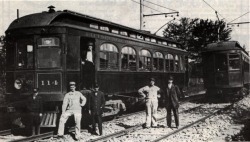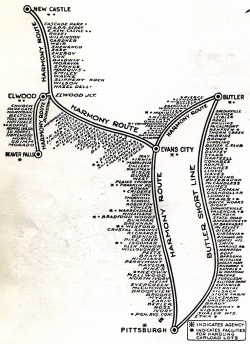The Impact of the Harmony Short Line

A red and gold trolley car of the Harmony Short Line.
http://www.fyi.net/~zhs/HarmonyLine/welcome.htm = All Aboard the Harmony Line!
More than any other factor, the proverbial key that opened the door to Cascade Park in Lawrence County was the new form of transportation that developed during the 1890's, the electric street railway car. The electric street railway car, better known as the trolley, replaced the horse-drawn urban railcar almost completely by the turn of the Twentieth Century. Trolley parks like Cascade Park, emerged first and foremost as a promotional tool for electric street railways, but also represented a new concept in American recreation. Along with the local trolley service set-up to run from downtown New Castle to Cascade Park by the New Castle Traction Company, the Harmony Short Line, which was operated by the Pittsburgh, Harmony, Butler, and New Castle Railways Company included among its most popular destinations a stop at Cascade Park as well. Each year, the Harmony Short Line carried thousands of riders between Pittsburgh and New Castle via one of three main routes transversing western Pennsylvania.
The line began service in 1908, and owned twenty-five individually operated passenger cars that were powered by overhead electrical wires. Each individual car had a trolley pole located on the roof that conducted the power from the overhead wire and channeled it to each of the car's four seventy-five horsepower motors. The Harmony Short Line's cars were reported to achieve up to eighty or ninety miles per hour on straight, level stretches of track. In addition to the multiple powerful engines, each trolley car was equipped with air brakes and sand holders (designed for emergency stops). The cars were designed to accomodate up to fifty passengers, but were commonly overloaded to twice that number during peak times. The standard trolley interior set-up included a separate compartment for the motorman who operated the car from the front. Passengers boarded from either side at the rear of the car. The cars were equipped with soft, plush seats to make the journey more enjoyable. Service from New Castle to Pittsburgh, Pennsylvania began to on November 12, 1908 and cost eighty-five cents. The average trip from New Castle to Pittsburgh was said to take approximately one and one-half hours.
During the mid-1920's, business began to slow for the Harmony Short Line as highways were improved and more families could afford to own automobiles. By the time of the Stock Market Crash in 1929, a number of runs had been cut out altogether and service was sharply reduced. The final trolley run to Pittsburgh from New Castle was made in June of 1931. Although relatively short-lived, the overall impact of the Harmony Short Line on the success of Cascade Park cannot be overlooked. The electric trolley car allowed for thousands of individuals from all over western Pennsylvania and the entire tri-state area to frequent the park during the first few decades of the Twentieth Century.
More than any other factor, the proverbial key that opened the door to Cascade Park in Lawrence County was the new form of transportation that developed during the 1890's, the electric street railway car. The electric street railway car, better known as the trolley, replaced the horse-drawn urban railcar almost completely by the turn of the Twentieth Century. Trolley parks like Cascade Park, emerged first and foremost as a promotional tool for electric street railways, but also represented a new concept in American recreation. Along with the local trolley service set-up to run from downtown New Castle to Cascade Park by the New Castle Traction Company, the Harmony Short Line, which was operated by the Pittsburgh, Harmony, Butler, and New Castle Railways Company included among its most popular destinations a stop at Cascade Park as well. Each year, the Harmony Short Line carried thousands of riders between Pittsburgh and New Castle via one of three main routes transversing western Pennsylvania.
The line began service in 1908, and owned twenty-five individually operated passenger cars that were powered by overhead electrical wires. Each individual car had a trolley pole located on the roof that conducted the power from the overhead wire and channeled it to each of the car's four seventy-five horsepower motors. The Harmony Short Line's cars were reported to achieve up to eighty or ninety miles per hour on straight, level stretches of track. In addition to the multiple powerful engines, each trolley car was equipped with air brakes and sand holders (designed for emergency stops). The cars were designed to accomodate up to fifty passengers, but were commonly overloaded to twice that number during peak times. The standard trolley interior set-up included a separate compartment for the motorman who operated the car from the front. Passengers boarded from either side at the rear of the car. The cars were equipped with soft, plush seats to make the journey more enjoyable. Service from New Castle to Pittsburgh, Pennsylvania began to on November 12, 1908 and cost eighty-five cents. The average trip from New Castle to Pittsburgh was said to take approximately one and one-half hours.
During the mid-1920's, business began to slow for the Harmony Short Line as highways were improved and more families could afford to own automobiles. By the time of the Stock Market Crash in 1929, a number of runs had been cut out altogether and service was sharply reduced. The final trolley run to Pittsburgh from New Castle was made in June of 1931. Although relatively short-lived, the overall impact of the Harmony Short Line on the success of Cascade Park cannot be overlooked. The electric trolley car allowed for thousands of individuals from all over western Pennsylvania and the entire tri-state area to frequent the park during the first few decades of the Twentieth Century.

